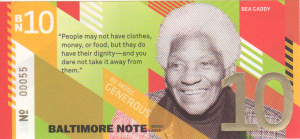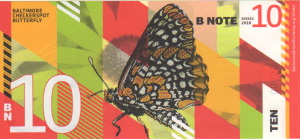Last April, the Baltimore Green Currency Association, sponsor of the BNote, initiated an Indiegogo campaign to fund their next issue that would feature significant women in Baltimore history. Although the campaign fell a little short, an anonymous donor funded more than $10,000 of the balance to print the currency.
Notes are a local currency that can be used at participating businesses in and around Baltimore. Currently, there are over 230 businesses accepting the BNote for goods and services. Consumers can receive BNotes as change for a transaction or may visit one of the official cambios (money exchange locations) to exchange dollars for BNotes. For every $10 that is exchanged for BNotes, you will receive a 10-percent bonus, which means if you exchange $10 you will receive BN11. You can also exchange BNotes for dollars at a reverse rate (receive $10 for every BN11 in BNotes).
The first BNotes were issued in April 2011 featuring the designs of Fredrick Douglas on the BN1 note and Edgar Allan Poe on the BN5 note. The reverse of the notes features a Baltimore oriole (the bird, not a ball player) on the $1 BNote and a raven on the reverse of the $5 BNote. For this new issue, Douglass and Poe remain on the note but the design changed to incorporate the vertical bars of the Calvert coat of arms that is incorporated in the Maryland flag.
- Baltimore BN1 BNote with portrait of Frederick Douglass
- Back of Baltimore BN1 BNote featuring a Baltimore Oriole (batting leadoff)
- Baltimore BN5 BNote with portrait of Edgar Allan Poe
- Back of Baltimore BN5 BNote with image of a Common Raven (Nevermore!)
The new BN10 and BN20 notes are similar in design with new colors on the background. Bea Gaddy is featured on the front of the BN10 and the Baltimore Checkerspot Butterfly, the official Maryland State Insect, on the reverse. Lillie May Carroll Jackson appears on the front of the BN20 note and a Blue Crab, the official Maryland State Crustacean, on the reverse.
Bea Gaddy was known as the Mother Teresa of Baltimore. A single mother of five who ended up in baltimore in 1964, she was discovered by a Baltimore attorney who encouraged her to go to college. Gaddy earned her bachelor’s degree in human services from Antioch University in 1977.
- Baltimore BN10 BNote with portrait of Bea Gaddy
- Back of Baltimore BN10 BNote with image of a Baltimore Checkerspot Butterfly, the Maryland State Insect
Gaddy saw the need to help others and joined the East Baltimore Children’s fund where she used her own home as a distribution point for clothing and food for the poor. She founded a homeless shelter which eventually became the Bea Gaddy Family Center, which is still in operation today.
In 1981, using the $290 she won on a 50-cents lottery ticket, she bought enough food to feed 39 neighbors and eventually opened a community kitchen for the needy. From Thanksgiving dinners to opening furniture bank refurbishing used furniture and rehabbing abandoned row houses, Gaddy was a catalyst to help the poor in Baltimore. Eventually, she became an ordained minister to perform marriages and hold funerals at no cost to the families.
Gaddy was diagnosed with breast cancer in 1998. With the cancer in remission, Gaddy ran for Baltimore City Council in 1999 and won. Unfortunately, the cancer returned and she died in October 2001 at the age of 68. Even though Bea Gaddy is gone, her family and friends continue to help the poor in Baltimore using the same love and compassion Bea showed throughout her life.
Dr. Lillie May Carroll Jackson was born in Baltimore in 1889 and is consider the mother of the civil rights movement. From 1935 through 1970, Jackson was the president of the Baltimore chapter of the NAACP and at the forefront of nearly every fight to end Maryland’s Jim Crow laws. Through her leadership, the Baltimore NAACP sued to remove the color barrier from admissions to the University of Maryland Law School, won cases to force Baltimore public schools to grant equal pay to white and black teachers, and was fundamental to having Baltimore to be the first school system south of the Mason-Dixon line to integrate their schools following the landmark Brown v. Board of Education decision.
- Baltimore BN20 BNote with portrait of Lillie May Carroll Jackson
- Back of Baltimore BN20 BNote with image of a Blue Crab, the Maryland State Crustacean
Jackson fought for equal pay and fair employment practices even though Maryland Governor Theodore McKeldin (R) was once quoted as saying, “I’d rather have the devil after me than Mrs. Jackson. Give her what she wants.” In the end, Jackson won most of the fights.
She is also credited with playing critical roles in the passage of federal civil rights legislation in the 1960s.
Jackson died from a heard attack in 1975. After she died, her will called for her Baltimore home to be turned into a civil rights museum. The museum opened in 1978 with memorabilia from Jackson’s life and documents chronicling her life’s work. It was the only museum named after a woman and the only civil rights museum in Maryland. The museum closed in the 1990s because it was too difficult to maintain as a private facility. The museum was transferred to Morgan University who refurbished the building and reopened it on June 11, 2016.
As part of the Indigogo campaign, I selected the option to receive the a full set of the second series BNotes with matching serial numbers. The notes I received, which feels like they were printed on heavy stock paper, a type of paper my wife said was “resumé” paper. All four notes feature serial number BN00055. For all you liar’s poker players, I call a full house.
What do you mean I can’t call a full house?!









